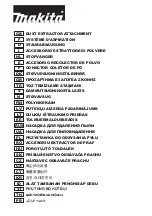
14
Declared total value of vibrations can be used for
preliminary setting of exposition.
Warning:
Emission of vibrations during real operating can
be different from declared total value of vibrations
depending on speci
fi
c real conditions.
To protect operating person shell be provide safety
measurement, that evaluate the exposition un-
der the real conditions (here are included all parts
of operating cycle, switch of mode and idle run
mode).
5 Commissioning
5.1 Changing the battery pack
Removing the battery pack
Press and hold the two buttons [2-1].
Slide the battery pack forwards to remove.
Inserting the battery pack
Slide the battery pack onto the retainer on the
underside of the handle shown in Fig. [2] until it
engages.
5.2 Charging the battery pack
►
The battery pack is delivered partially charged.
Charge the battery pack completely before using
for the
fi
rst time.
To charge the battery pack, slide all the way onto
the retainer [3-2] on the charger.
►
To remove, slide the charged battery pack from
the charger in similar fashion.
The charger automatically detects the type of the
inserted battery (NiCd, NiMH or LiIon).
A microprocessor controls the charging process in
line with the charging state, temperature and volt-
age of the battery pack. If a warm NiMH battery
pack (> 37 °C) is inserted, the pack is charged with
a reduced charging current and will take longer to
charge.
The LED [3-1] on the charger indicates the respec-
tive operating status of the charger.
LED yellow – lit continuously
Charger is ready to use.
LED green –
fl
ashing quickly
Battery pack is charged to maximum capacity.
LED green –
fl
ashing slowly
Battery pack is charged with reduced current, LiIon
is charged to 80 %.
LED green – lit continuously
Battery pack is fully charged, conservation charg-
ing active.
LED red – lit continuously
Battery temperature is outside the permitted
range.
LED red –
fl
ashing
General fault display, e.g. incomplete contact, short
circuit, battery pack faulty, etc..
5.3 Wall
mounting
There are two elongated holes on the back of the
BC 3 for mounting the charger to a wall using two
screws (e.g. round head or
fl
at head screw with
shank diameter of 5 mm).
Insert the two screws into the wall at a distance
of 96 mm from one another and leave the screw
heads protruding approx. 4 mm.
6 Machine
settings
►
Setting must be done only when the machine
is turned off and will be accepted only after
restarting it.
6.1 Changing the direction of rotation
The right/left switch [1-3] changes the direction
of rotation.
Move switch from right to left = clockwise rotation;
Move switch from left to right = anticlockwise rota-
tion.
6.2 Changing
gear
►
Always switch off the machine before changing
gear!
You can change gear using the gear switch [1-4].
6.3 Fastening
Move the switch [1-5] to the torque setting.
Setting on 1
= low torque
Setting on 12
= high torque
The machine switches off when the preset torque
is reached and an acoustic signal sounds. You must
release and press the ON/OFF switch [1-2] again
to start the machine.
Upon levels 1 – 12, a decreased number of rota-
tions can be set.
6.4 Drilling
The selector switch [1-5] is set to the drill symbol
marking = maximum torque.
7 Tool holder, attachments
7.1 Chuck
The chuck is used for clamping drill and screw-
driver bits.
Attaching the chuck
►
Before
fi
rst use, the spindle [4-1] should be paint-
ed with a thin layer of multipurpose grease.
Attach the chuck to the drill spindle [4-1].
Pull the release ring [4-2] forwards.
Turn until the hexagon pinon the chuck engages in
the hexagon socket holder in the drill spindle.
Push the chuck all the way onto the drill spindle.
Release the ring [4-2].
Detaching the chuck
Pull the release ring [4-2] forwards.
Remove the chuck.
Summary of Contents for QuaDrive DRC 12-4 TEC
Page 1: ...QuaDrive DRC 12 4 TEC DRC 18 4 TEC 701235_001 ...
Page 3: ...3 2 1 3 1 3 2 1 7 ...
Page 4: ...4 ...
Page 103: ......















































